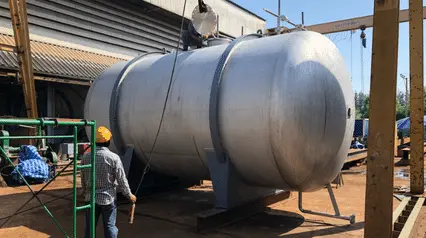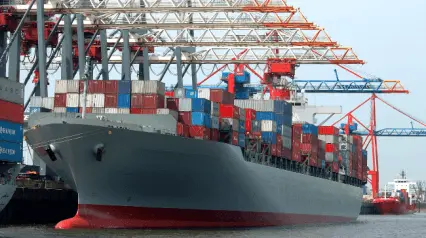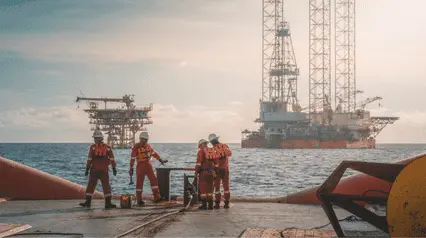What are Pressure Vessels?
Pressure vessels are containers designed to hold fluids or gases at high pressures. They can be found in various settings, from industrial boilers to scuba tanks. Pressure vessels are highly regulated and must meet strict safety standards to ensure they can withstand the extreme pressures they are subject to.
In addition to steel, pressure vessels can also be made from aluminum or composite materials. Pressure vessels can be either spherical or cylindrical in shape and range in size from small tanks one person can carry to massive industrial vessels several stories tall. Regardless of their size or shape, all pressure vessels share one common goal: safely contain their contents at high pressures.
What are the Different Pressure Vessel Standards?
Several standards and regulations control every part of pressure vessels. However, the American Society of Mechanical Engineers (ASME) Boiler and Pressure Vessel Code (BPVC) is a widely accepted standard.
As part of its responsibilities, the department designs, constructs, installs, tests, inspects, and certifies boilers, pressure vessels, and nuclear power plant components. Section VIII of the ASME BPVC governs pressure vessels. It has three divisions:
Division I
It encompasses all pressure vessels designed to operate at an internal or external pressure that may exceed 15 psig. It’s possible to use a fired or an unfired vessel and to obtain pressure through an external source or indirect heating. Engineers adapt the design-by-rule approach. Division I is based on normal stress theory.
Division II
This section covers all pressure vessels that are meant to operate with internal or external pressures up to 10,000 pounds per square inch. The requirements for materials, design, and nondestructive examination in Division II are more stringent than in Division I. It means that the calculations required are more detailed.
Engineers in this division use design-by-analysis to subject pressure vessels to higher stress levels. Unlike Division I, it is based on maximum distortion energy theory.
Division III
It identifies the required and not allowed pressure vessels for use above 10,000 pounds per square inch.
Another standard that maintains the integrity of pressure vessels is API 510 Pressure Vessel Inspection Code for In-Service Inspection, Rating, Repair, and Alteration.
Create Your Own Pressure Vessel Inspection Checklist
Eliminate manual tasks and streamline your operations.
Get started for FREETypes of Pressure Vessels
There are different types of pressure vessels based on their shape or function. Types of pressure vessels include:
Types of Pressure Vessels According to their Purpose
Storage Vessels
Storage vessels are pressure containers that hold liquids, vapors, and gases. It’s possible to reuse vessels for future processes or to store finished products like compressed natural gas (CNG) and liquid nitrogen.
Heat Exchangers
Heat exchangers help to transfer heat between two or more fluids. Bioprocessing, food, pharmaceutical, and energy industries use them most often. Equipment for heat exchangers is designed according to the thermal and flow properties of the fluids involved in heat exchange and according to the thermal property of the conductive partition (for indirect contact heat exchangers). Heat exchanger materials are stressed by the temperature difference between hot and cold fluids and their internal pressure.
Boilers
Boilers are machines that use different types of energy to create heat. Liquids are then turned into vapor using this heat. A boiler is usually composed of metal containers that transfer heat from a source to a fluid. Steam from the boiler is used for a variety of purposes. The boiler makes the steam go faster so it can turn the turbine blades. The boiler must be solid to handle all the pressure and heat. Most materials get weaker when they get hotter.
Process Vessels
Process vessels are big containers where industrial processes happen, like mixing and stirring, decanting, distilling and separating chemicals, and chemical reactions. The pressure inside a process vessel changes depending on the process and the substances used.
Types of Pressure Vessels According to their Geometry
Spherical Pressure Vessels
Spherical pressure vessels are suitable for holding liquids under a lot of pressure. They are robust and not easy to break, but they are hard and costly to make. The pressure is spread out evenly on the sphere, so there are no weak points. Spheres also don’t take up as much space as other shapes. Spherical vessels will use less material than cylindrical vessels if they are the same size. Spherical vessels are also less likely to transfer heat than other shapes due to their smaller surface area.
Cylindrical Pressure Vessels
Cylindrical pressure vessels have a cylindrical shell and one or more heads. The cylindrical shell is the main body of the pressure vessel. The heads are like end caps that cover the contents of the vessel and may have a flatter or more rounded profile. It reduces the cylindrical container’s weakness.
Cylindrical pressure vessels are among the most popular type because of their many possible applications. They’re less expensive to produce than spherical vessels but not as durable. It then requires cylindrical pressure vessels to have thicker walls to withstand equal amounts of pressure than a spherical vessel.
What are the Different Vessel Orientations?
A cylindrical vessel may have a horizontal or vertical axis depending on its purpose.
Vertical Vessel Orientation
- For small floor space
- For small-volume vessels
- For efficient mixing of fluid in mixing tanks
- When the gas-to-liquid ratio is high
- For easier removal of components in liquid-liquid separation
Horizontal Vessel Orientation
- In heat exchangers for easier cleaning
- In settling tanks and flash drums to have less entrainment
What are the Criteria for Materials Selection for Pressure Vessels?
- Can meet the strength requirements – The materials used to make the pressure vessel must be strong enough to last during its service life. It includes withstanding specific internal and external pressures and structural stresses.
- Corrosion resistance – This is essential for pressure vessels because they need to work well under challenging conditions.
- Return of investment – A pressure vessel’s lifespan must consider materials, fabrication, and maintenance costs.
- Ease of fabrication and maintenance – Metal sheets must be machinable and weldable to form the pressure vessels’ geometry. It will be easier to install the vessel’s internals this way.
- Availability – The sizes for pressure vessel materials must be easy to find near the manufacturer.
What are the Commonly Used Materials for Pressure Vessels?
The most popular materials used to construct pressure vessels are:
- Carbon steel
- Stainless steel
- Hastelloy
- Nickel alloys
- Aluminum
- Titanium
What are the Different Quality Testing and Inspection of Pressure Vessels?
The following are testing methods employed to ensure the reliability and factor of safety of the pressure vessel.
Visual Testing
A certified inspector inspects pressure vessels at least once every five years. They will check the vessel’s interior and exterior for any cracks, deformation, blistering, fluid leakage, corrosion, or other damages that might have occurred.
Ultrasonic Testing
This tool uses high-frequency sound waves to detect surface or subsurface flaws and measure the pressure vessel’s wall thickness. The material absorbs the ultrasonic sound waves and turns them into an electrical signal via a transducer. If there happen to be any flaws present, the reflected waves will be disturbed.
Radiographic Testing
A radiographic test involves using x-rays or gamma rays to create a picture of what lies beneath a pressure vessel’s surface. Discontinuities, holes, and density differences will change how waves reflect. The film will then be exposed after this.
This method produces consistent results; hence it’s widely used. However, radiation exposure is expensive and requires specialized training.
Magnetic Particle Testing
The machine uses magnetic current to detect surface imperfections in ferromagnetic materials. The inspector runs a magnetic current through the pressure vessel between two probes. If the material is free from defects, the flux flows smoothly through it. But if cracks or other abnormalities are present, some of the magnetic flux will leak out of material around those areas. These imperfections will be more visible once ferromagnetic particles—in either liquid suspension or powdered form—are applied to the hull’s exterior.
Liquid Penetrant Testing
An inspector applies a small amount of liquid called a penetrant to an area with welded seams or plates that may have flaws. Once the penetrant settles after spraying, the excess is wiped from the surface before applying developer, revealing any penetrant that has seeped into cracks.
Pressure Testing
The ASME BPV Code requires strength and leak tests. Pressure testing uses either hydrostatic or pneumatic methods—the former uses water as a medium, while the latter uses air or nitrogen. The process works by removing all air within the vessel before filling it with test fluid until 1.5 times design pressure for hydrostatic testing and 1.2-1.5 times design pressures for pneumatic tests have been reached, internalizing said pressure, respectively. Industry experts recommend hydrostatic testing over pneumatic methods because of the safety risks posed by the potential energy levels in pneumatic testing.
FAQs About Pressure Vessel
Spherical pressure vessels, or spheres, are commonly used to store high-pressure fluids since they’re structurally sound. The even distribution of stresses on a sphere’s exterior and interior surfaces typically leaves no weak points vulnerable to collapse.
An ellipsoidal head has a 2:1 change in radius between the major and minor axes, and its shell has matching wall thickness. This head’s tall and light weight makes it ideal for holding high-pressure gases. It can manage pressures higher than 15 bars.
Pressure vessels must meet the size specified in the ASME Boiler and Pressure Vessel Code (ASME BPV code). Informally, this usually refers to any closed container over 150 mm in diameter and will experience a pressure difference of more than 0.5 bar.
Pressure vessels store gases or liquids at a pressure above atmospheric pressure, with some Maximum Allowable Operating Pressures (MAOP) reaching as high as 150,000 PSI. Storage tanks also hold gases or liquids only at atmospheric pressure and have an MAOP of 15 PSI.




